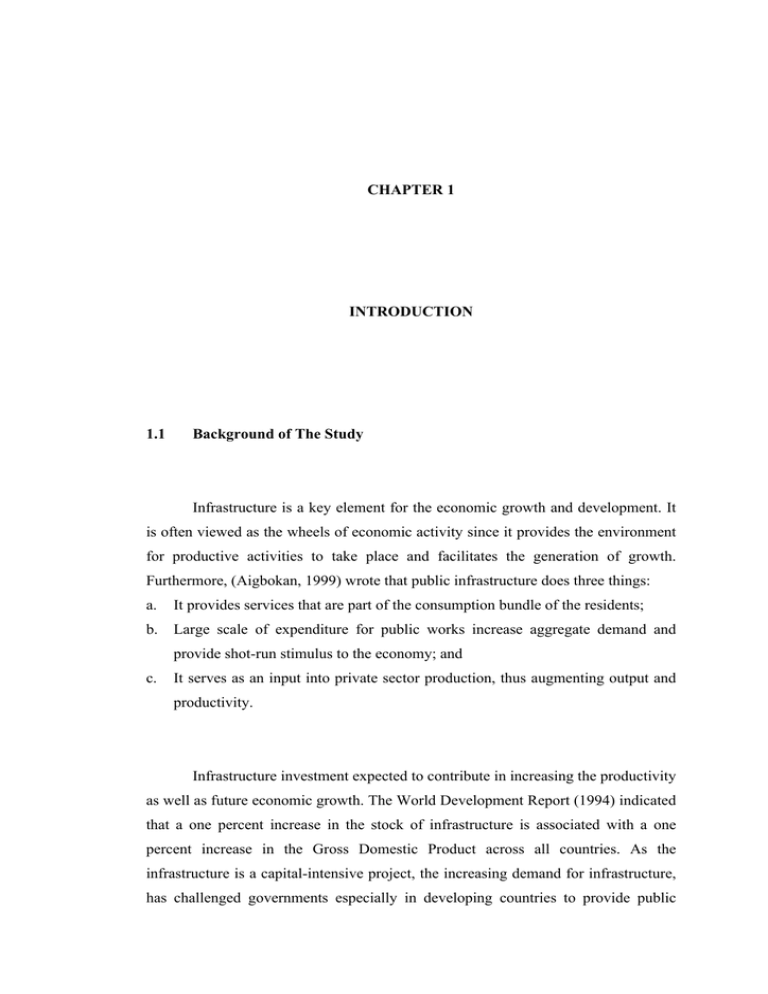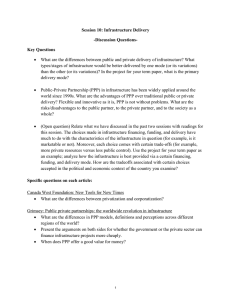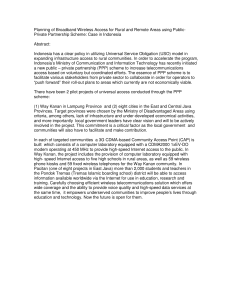1 Infrastructure is a key element for the economic growth and... is often viewed as the wheels of economic activity since...
advertisement

1 CHAPTER 1 INTRODUCTION 1.1 Background of The Study Infrastructure is a key element for the economic growth and development. It is often viewed as the wheels of economic activity since it provides the environment for productive activities to take place and facilitates the generation of growth. Furthermore, (Aigbokan, 1999) wrote that public infrastructure does three things: a. It provides services that are part of the consumption bundle of the residents; b. Large scale of expenditure for public works increase aggregate demand and provide shot-run stimulus to the economy; and c. It serves as an input into private sector production, thus augmenting output and productivity. Infrastructure investment expected to contribute in increasing the productivity as well as future economic growth. The World Development Report (1994) indicated that a one percent increase in the stock of infrastructure is associated with a one percent increase in the Gross Domestic Product across all countries. As the infrastructure is a capital-intensive project, the increasing demand for infrastructure, has challenged governments especially in developing countries to provide public 2 service with the shortage of the available public funds. This condition has led to the creation of alternative resources on project financing. Government encourages private sector to play active role in providing public infrastructure under the scheme of public private-partnership project. Public-private partnership is recognized as an effective way of delivering value-for-money public infrastructure or services. It seeks to combine the advantages of competitive tendering and flexible negotiation, and to allocate risk on agreed basis between the public sector and the private sector (Li, et.all, 2005). In Indonesia Economic Acceleration and Expansion 2011-2015 Master Plan, infrastructure become one of the main issues particularly infrastructure that promote connectivity between regions so that it can accelerate and expand the economic development of Indonesia. Indonesian Government has recognized the vital role of the private sector in fulfilling these needs and has been laying the foundation for private sector participation in infrastructure development through private-public partnerships (PPP). Specifically, the Government is targeting IDR 980 trillion (approximately USD 94 billion) in private sector investment under this PPP scheme over the 20102014 periods (The Coordinating Ministry for Economy. 2011). In the rapidly developing economies such as the countries in the East Asian region, concessions as well as build and operate agreements for large-scale infrastructure networks (i.e. tollways) have been the main interest (Li and Akintoye, 2003). In Indonesia, the private sector has been allowed to invest in toll road projects through build, operate and transfer (BOT) schemes since the early 1990s and the expansion of private participation in infrastructure has made significant progress since then. 3 In February 2010 Jakarta Outer Ring Road W1 (JORR W1) starting operate as part of Jakarta Outer Ring Road System and alternative access for transport goods toward the Tanjung Priok Port and Soekarno-Hatta Airport. Private company under the Build, Operate, and Transfer (BOT) scheme runs the 9,35 km road. The road is part of Greater Jakarta Toll Road Network. The location of the project can be seen in the figure 1.1 Figure 1.1 Location of the Project JORR W1 Source : civilhighway.wordpress.com 4 Just like other infrastructure project, JORR W1 toll road project encounter constraints that affected the project performance and considered as the risk of the project. Zayed and Chang (2002) found that risk in BOT project can be classified to the following project phases : a. Development phase (technology, credit, and bid risks); b. Construction phase (completion, cost overrun, performance, and political risks); c. Operating phase (performance, cost overrun, liability, equity resale, and off take risks); and d. Ongoing risks (interest rate and currency risks) As the JORR W1 project already in operating phase, it is necessary to do a review on the risk in the construction phase and what the risk management strategy in order to completed the project to gain understanding on how risk is managed in PPP project, and to give references on how to develop proper risk management in the future PPP projects. 1.2 Problem Statement Infrastructure projects, particularly toll road construction requires a large investment with a very long construction period. The number of factors and stakeholders involved, led to the risk of the project implementation. Sources of risk can be interpreted as factors that could cause events that are negative or positive. For example, below is the source of the risk of a project: a. Risks associated with management b. Risks associated with technical and implementation c. Risks associated with contractual and legal d. Risks related to economic, social, and political 5 The risk is believed to be unavoidable. With regard to the public sector which demands transparency and performance improvements with limited funds, the risks faced by government agencies will be growing and increasing. Therefore, an understanding of risk become important to be able to determine priorities and program strategies in the achievement of organizational goals. The success of the project depends on how the risk can be managed. That is, events that have effect on cost, quality, and construction time. Proper risk management regarded as the key factors of project success. Since Indonesia is increasingly recognizing the need to attract private investment for its toll road development and to establish constructive partnership between private and public sector, it is necessary to discover proper risk management in toll road construction especially under the Public Private Partnership scheme. 1.3 Research Questions In this research, there are some questions that need to be answered in order to achieve the objectives, namely: a. What is the Public Private Partnership project definition? b. How the implementation of PPP projects in Indonesia? c. What are the problems usually occur in PPP project in Indonesia? d. How does risk management in PPP project in Indonesia applied? Hopefully by answering the above questions we can gain clearer understanding on risk management in PPP project in Indonesia. 6 1.4 Research Objectives Based on the problem statement and the research question above, this study will attempt to: a. Identify the risk in PPP projects. b. Identify the potential risk that affected the construction process. c. Identify risk management in the construction process. 1.5 Scope of The Research The scope and the limitation of the study: a. The research is limited for PPP projects in toll road development under BOT scheme. b. The study will be focused on Jakarta Outer Ring Road W1 (JORR W1) toll road project. c. 1.6 The study will be focused on risk during the construction process. Research Significance The study seeks to gain clearer understanding of how risk is managed in PPP project, and to give references on how to develop proper risk management in the future PPP projects. 7 1.7 Organization of the Report The followings are the summary of each chapter on this research project paper.. This study is composed of five chapters as follow : Chapter 1 presents the introduction, which is including background of the study, problem statement, objective of the study, scope of the study, importance of the study, and research methodology Chapter 2 will reviews literature data relating to risk allocation, Indonesian toll road development, legal basis of Indonesian toll road development, and also the description of Indonesia’s Public-Private Partnership practice. Chapter 3 describes the methodology that adopted to conduct this research, which describe the object of study, finding data method, analysis method. Chapter 4 presents data analysis result on the risk allocation in PPP project, discussions and the literature review findings as an achievement of the objective of this research. Chapter 5 presents the conclusion of this research and recommendations for future research.


